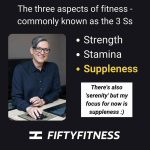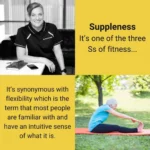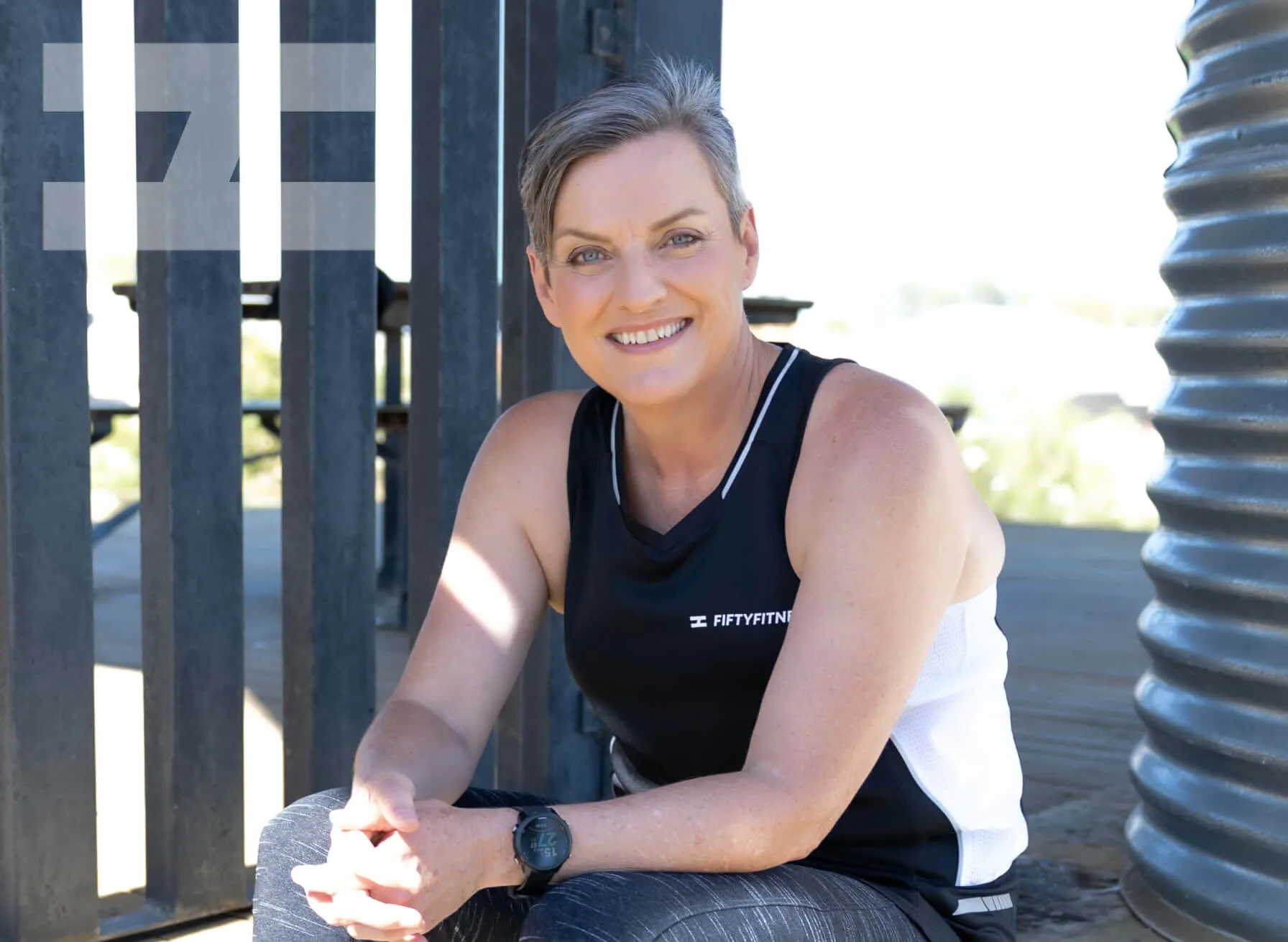Are you supple? The importance of flexibility and how to improve it

The suppleness aspect of fitness
There are three aspects of fitness which are commonly referred to as the three Ss.
- Strength
- Stamina – also known as endurance
- Suppleness – also known as flexibility

There’s also ‘serenity’
If you’ve seen other articles from my blog, you may know that I believe in another aspect of fitness – serenity.
This is all about how exercise can make us feel – physically, mentally and emotionally.
In my opinion, serenity should be the fourth aspect of fitness because it’s just as important as the three Ss.
I set an intention earlier this year to share articles that highlight each of the classic three Ss individually.
Here are the ones on strength and stamina in case you missed them.
This article is about suppleness.
What it is, why do we need it over 50 and how do we improve it?

What is suppleness?
Suppleness is a synonym for flexibility that starts with the letter S 😊
Flexibility is the term that most people are familiar with and have an intuitive sense of what it is.
It’s the range of movement we have about our joints and is a key component of mobility and the ability to perform our daily living, leisure and physical fitness activities.
While it involves the extent of joint movement that we can perform, flexibility is influenced by the soft tissues – muscle, tendons, ligaments – around the joints. Their ability to lengthen.
You may already be experiencing the fact that flexibility decreases with age. Can you move your body to crouch or get down onto the ground to do the things you need to do in that position?
This is the most common manifestation of declining flexibility that people tell me about.
The good news is that flexibility, and therefore mobility, can be maintained and improved by keeping both muscle and connective tissue healthy through exercise.

Why do we need suppleness?
Here is an extensive list of the benefits of flexibility I found when researching this article.
There are heaps!
- Decreased injury risk – with increased range of movement about our joints we are less likely to get injured during physical activity.
- Improved performance through enhanced mobility and power.
- Better posture – being more flexible can help us hold our bodies in good alignment.
- Improved balance and coordination, which has the added benefit of reducing the risk of falls in older people.
- Increased self-confidence –improving flexibility can help us feel more confident in what our bodies are capable of.

Benefits of stretching
The best-known way to improve flexibility is through stretching.
Here are some great things about stretching that popped up in my research.
- Reduced muscle tension and pain – improving flexibility through stretching can help to release muscle tension and reduce pain.
- Improved circulation.
- Stretching may promote relaxation which may enhance sleep quality and reduce feelings of stress and anxiety.
- Stretching practices may contribute to enhancing mood and boosting energy levels.

Different ways of stretching
There are two main ways that we include stretching into our general fitness routines.
As part of the warmup phase when we’re getting our body ready to exercise it’s great to do some dynamic stretching. Then after the main workout we finish with static stretching.
Let’s distinguish these two types of stretching.
Dynamic stretching
As the name suggests, dynamic stretching involves movement.
Typically done at the beginning of a workout, dynamic stretching involves moving our major joints through their full range of motion. Starting gently and increasing the range as we warm up.
A classic example involves arms outstretched and reaching behind the body then swinging them around shoulder height to cross in front of the body then back again and repeating the movement.
I’m sure you can visualise lots of examples of dynamic stretches.
All my workouts with clients start with dynamic stretching as part of the warmup phase.
Static stretching
These are done at the end of a workout, and we hold a position for a period of time to perform a stretch.
There are different schools of thought on the length of time to hold a static stretch.
Within the context and time constraints of a typical workout, stretches are generally held for 30 seconds. That’s what I do at the end of my sessions.
When holding a stretch we should feel a little discomfort as the muscle is stretched, but this should not be painful.
Yoga and massage
Yoga is a great way to learn and progress with stretching and flexibility.
I love yoga and highly recommend its inclusion in a balanced fitness routine.
Even if you don’t love it or want to make it part of your regular activities, going occasionally will help you learn some stretches you can do any time.
Another factor that contributes greatly to my suppleness by releasing muscle tension is remedial massage.
I’ve been having a monthly remedial massage for a decade and swear that it’s one of the best things I do for my overall wellbeing. I know this is not for everyone though.
An accessible alternative is self-massage techniques with foam rollers and balls or massage ‘gun’.
Gauging improvement in suppleness
How do we know if our flexibility has improved?
There are objective measures such as the ‘sit and reach’ test, but I don’t think we need to worry about this.
I reckon we can tell subjectively if our suppleness has improved by noticing increased range of motion and the ease with which we can perform movements.

Other great things about stretching, in my opinion
I’ve identified a couple of other fantastic things about stretching in addition to all those benefits outlined earlier.
A gateway to increasing physical activity
If you’re not doing any exercise, stretching can be a great place to start and provide a gateway.
You can start a journey to regular physical activity with 5 minutes of daily dynamic stretching.
This can evolve into a warmup for a workout.
Feel the serenity
Then when you’re doing regular exercise it’s great to do static stretches at the end of a workout.
It’s during the cool down and stretch that serenity can start to kick in.
When you’re stretching after a workout where you may have challenged yourself a bit, you can feel buzzed and energised in your body, as well as feelings of pride and satisfaction. Serenity.
An attainable way to get started
If you need an easy way to get started with increasing your physical activity, this free video series is for you.
You will learn a series of 9 dynamic stretches one at a time with a daily email from me containing a video demonstration and explanation.
Once you know all the moves you can do them in 5 minutes every morning to free up your body, improve your mood and feel energised for the day ahead.
As you gain motivation to increase your physical activity, the daily routine will become the warmup for your workout.
Learn more and get started here https://bit.ly/NiceAndEasyNewHabit
Keep in touch
Please reach out to me if anything in this article resonates with you.
You can email me at kate@fiftyfitness.com.au or connect via social media.

Subscribe now
Blog Subscription Form
A blog subscription form, used for the blog page and posts.
"*" indicates required fields